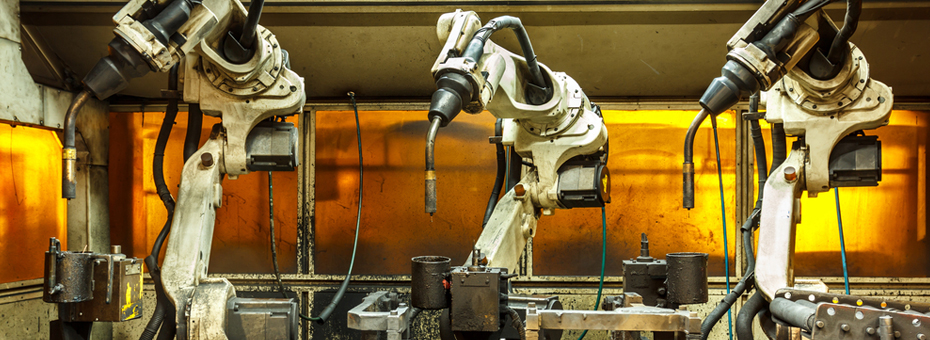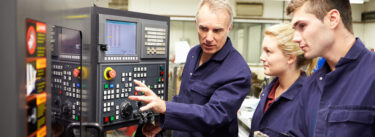Editor’s Note: This post is a companion piece to last month’s Ask Art on the conflict between lean and automation.
This is a great question because it highlights the misconception that most people have about lean. If you see lean as simply a cost reduction program (and probably 95 percent of managers and business owners see it that way), then this seems like a reasonable debate. It is also easy to predict which way the discussion will go. Most traditionally trained managers and engineers have been taught to think in terms of batch production, with equipment arranged into functional departments of similar machines. They are convinced that the larger the batch size the lower the cost will be for any different product or component part. They also believe that in order to reduce costs you must have fewer people. As a result, they will almost automatically favor investing in automation whenever possible.
To justify this high cost of automation they will need an aggressive sales forecast—even for an untested new product. This creates pressure to be very optimistic about top line sales growth. When everything works as expected, this can be fine; but more often than not the automation turns out to take longer and cost much more than the original forecast. Even once it gets going there are bound to be continuous breakdowns and other problems that require dedicated engineering support for months and even years, none of which were accounted for in the original forecast of cost. And then, even if you solve all the production problems, the sales forecast could prove to be way too high (three to ten times) vs. what actually happened. Which is why the automation ends up too expensive and the resulting cents each cost of the product to be un-economic.
But what if we looked at lean differently? What if we saw lean as a strategic way to run any business where the whole focus was on removing internal waste in order to deliver more value to your customers? Then the discussion wouldn’t be just about cost reduction, it would be about what drives value for the customer; e.g. short lead times, higher quality, rapid response to customer requests, ease of doing business, steady flow of new products, and yes reasonable pricing (driven by low costs). Instead of thinking in terms of batches, the bigger the better, the lean company is thinking in terms of flow, in fact, one-piece-flow. To the traditional big batch manager, of course this makes no sense at all.
Before considering whether and how to automate, you must first commit to something more fundamental: are you going to be a traditional or a lean company? The lean company will think in terms of TAKT time, i.e. the rate of customer demand, and as a result, will tend to start small and not be reliant on big optimistic sales forecasts. It will create simple, semi-automatic lines that can easily be expanded if sales rise but will not be a burden if the sales come in well below the original expectations. Instead of full automation to start with, the lean company will create chaku-chaku lines (load-load) where the operator will load and move the parts (the tricky and expensive part of full automation) and feed them one-by-one to semi-automatic machines designed to reliably do one simple function. The cost and efficiency of this approach will beat full automation just about every time. More importantly, if something about the product needs to change over time, the full automation guy will have a real problem, where the chaku-chaku company will be very flexible and can adapt to the change with little cost.
Let me share an example. I am familiar with a large international company which was dedicated to large full automation projects. This company bought a smaller US company with a plant in China that produced a product that competed with the larger company in the US market. The large company had invested more than $3 million in a fully automated machine for the US market. The smaller firm competed from its Chinese plant using several simple chaku-chaku lines that were quite manual in nature. The product quality of each company was quite similar, but the large company scoffed at the chaku-chaku lines.
Just to prove their point they did a study and were shocked to find that the Chinese plant could produce the product for $1 while their fully automated line had a cost of $3. Shortly after that UL (Underwriter Laboratory) changed the acceptable specifications for the product. The changes weren’t all that big but it meant that the product could no longer be made on the automated machine without spending several million dollars to alter it. Even if they were willing to do this the changes would stretch out beyond the deadline of when the new specs needed to be in place and they would be out of business until they caught up. Fortunately, it was very easy for the new China plant to adopt to the new specs and inexpensive to expand production to absorb all of the larger companies volume. The large full automation company was saved by its new acquisitions use of lean and chaku-chaku lines.
I don’t claim to be a Toyota expert even though I was trained by four ex-Toyota sensei, all of whom had worked directly for Taiichi Ohno, the father of the Toyota Production System.I do remember however that the two pillars of TPS were Just-In-Time and Jidoka. Jidoka meant autonomation or automation with a human touch. This came from Toyota’s founder, Sakichi Toyoda’s invention of a new weft breakage automatic stopping device in 1896. Toyota was a loom manufacturer in those days but the philosophy and principles of Jidoka carried over into automotive production.
In his book Toyota Production System, Ohno describes autonomation as “automation with a human touch,” pointing out that the goal of TPS is to use tools and visual methods as a way of building awareness by the people running the machines about when problems emerged and what to do about it—so that the operators and their leaders could respond immediately and flexibly to anything that cropped up. He in fact saw this akin to the nervous system in the human body that responds unconsciously without any directive from the brain:
“At Toyota, we began to think about how to install an autonomic nervous system in our own rapidly growing business organization,” he wrote, pointing out this would enable people to make judgments autonomously at the lowest possible level about such things as when to stop production to correct defects or what sequence to follow in making parts. “I think a business should have reflexes that can respond instantly and smoothly to small changes in the plan without having to go to the brain….Building a fine-tuning mechanism into the business so that change will not be felt as change is like implanting a reflex nerve inside the body.”
I was taught therefore, that applying these principles to eliminate the waste is a far better approach than trying to go to full automation. It doesn’t mean you can’t add automation as you go along or that automation per se is bad. In my experience, however, the lean one-piece-flow approach is always a better way to go than trying for full automation up front.





